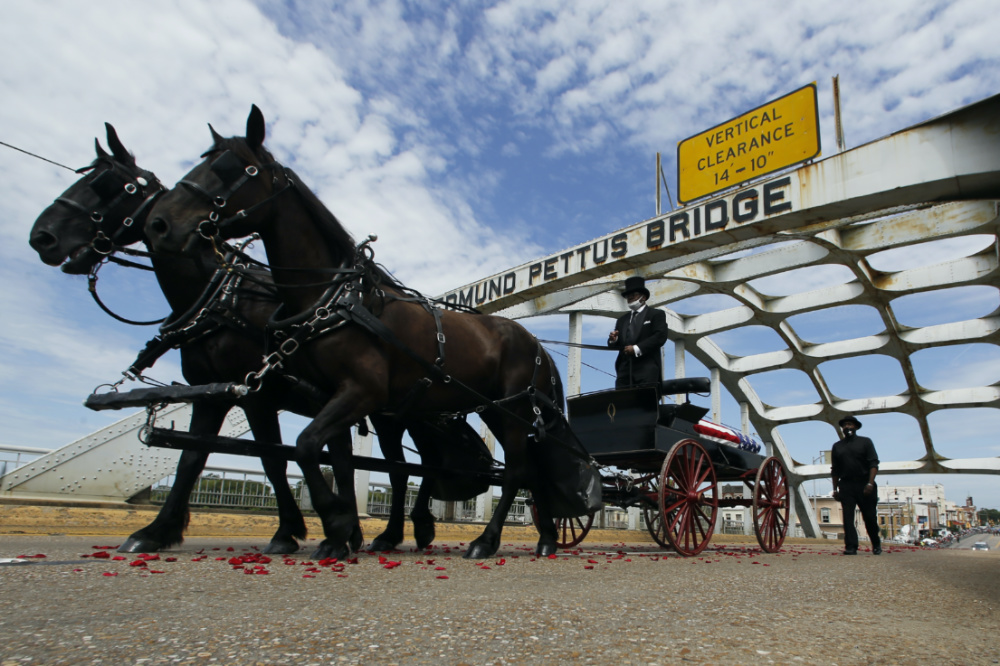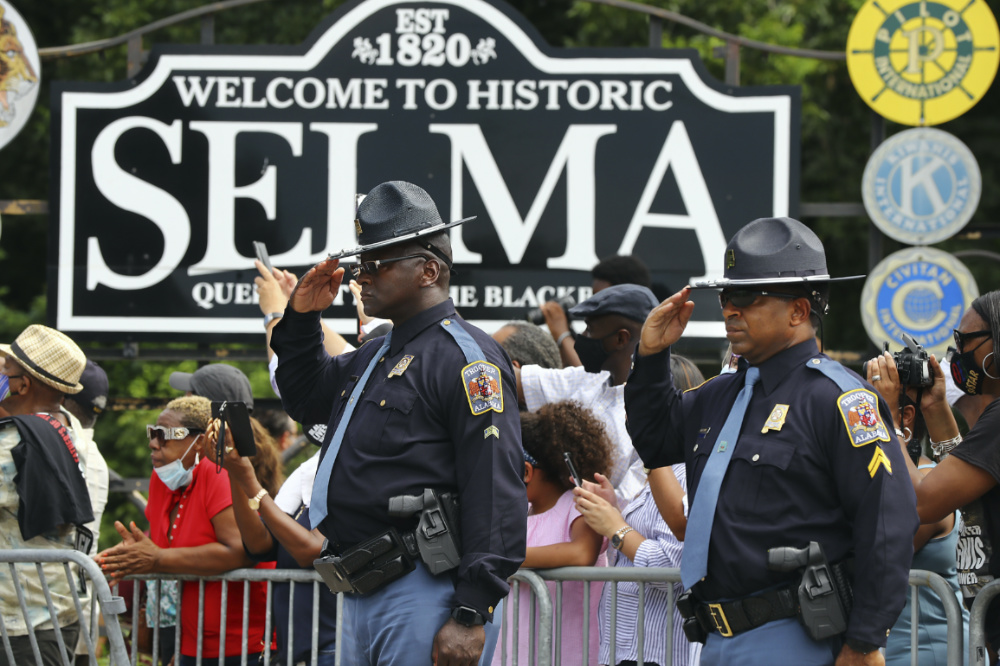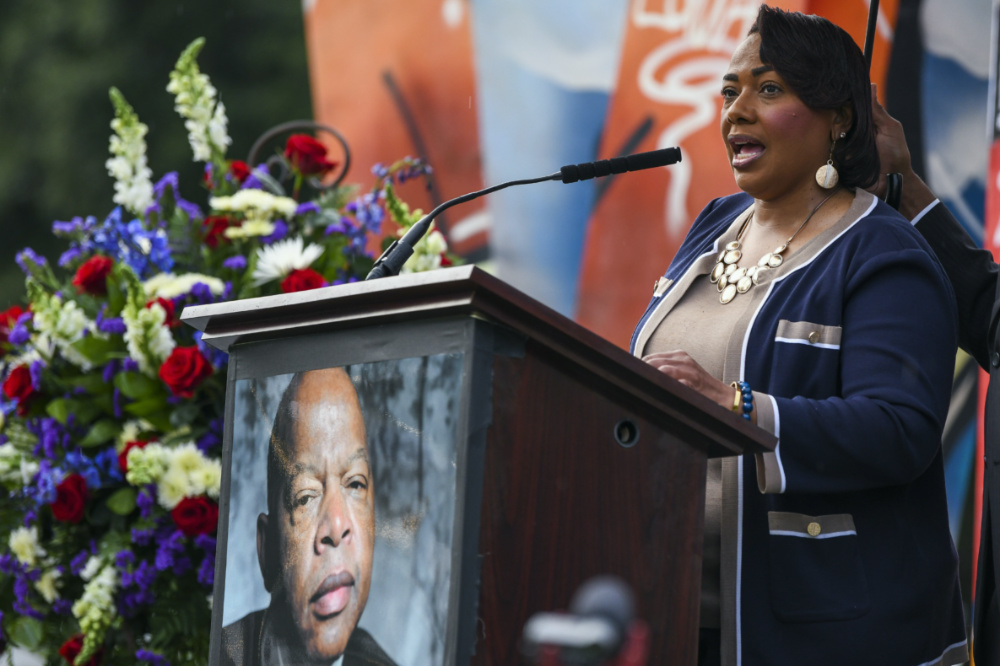Selma, Alabama
AP
The late US Representative John Lewis crossed the Edmund Pettus Bridge in Selma, Alabama, for the final time Sunday as remembrances continue for the civil rights icon.
The bridge became a landmark in the fight for racial justice when Lewis and other civil rights marchers were beaten there 55 years ago on “Bloody Sunday”, a key event that helped galvanise support for the passage of the Voting Rights Act. Lewis returned to Selma each March in commemoration.

The casket of Representative John Lewis moves over the Edmund Pettus Bridge by horse drawn carriage during a memorial service for Lewis, on Sunday, 26th July, 2020, in Selma, Alabama. Lewis, who carried the struggle against racial discrimination from Southern battlegrounds of the 1960s to the halls of Congress, died on Friday, 17th July, 2020. PICTURE: AP Photo/John Bazemore.
Sunday found him crossing alone – instead of arm-in-arm with civil rights and political leaders – after his coffin was loaded atop a horse-drawn wagon that retraced the route through Selma from Brown Chapel African Methodist Episcopal Church, where the 1965 march began.
As the black wagon pulled by a team of dark-coloured horses approached the bridge, members of the crowd shouted “Thank you, John Lewis!” and “Good trouble!” the phrase Lewis used to describe his tangles with white authorities during the civil rights movement.
Some crowd members sang the Gospel song Woke Up This Morning With My Mind Stayed on Jesus. Later, some onlookers sang the civil rights anthem We Shall Overcome and other Gospel tunes.
Lewis died on 17th July at 80, months after he was diagnosed with advanced pancreatic cancer. Lewis served in the US House of Representatives for Georgia’s 5th congressional district from 1987 until his death.
The wagon rolled over a carpet of rose petals, pausing atop the bridge over the Alabama River in the summer heat so family members could walk behind it. On the south side of the bridge, where Lewis was beaten by Alabama state troopers in 1965, family members placed red roses that the carriage rolled over, marking the spot where Lewis spilled his blood and suffered a head injury.
As a military honour guard lifted Lewis’ casket from the horse-drawn wagon into an automobile hearse, Alabama state troopers, including some African American ones, saluted Lewis.
Franz and Ellen Hill drove more that four hours from Monroe, Louisiana, to watch the procession.
Franz Hill, 60, said he remembers, as an African American child, watching news footage of Lewis and other civil rights marchers being beaten by law enforcement officers.
“I had to come back and see John Lewis cross this bridge for the last time,” said Hill. “It’s funny to see the state troopers waiting on him for a whole different reason, to honour and respect him rather than beat the crap out of him.”
There has been a movement to rename the Edmund Pettus Bridge after Lewis, but the idea has also faced opposition from those who note that Lewis wasn’t the only activist beaten on the bridge that day.

Alabama troopers salute the body of Representative John Lewis making the final crossing over the Edmund Pettus Bridge, site of the historic 1965 voting rights marches, on Sunday, 26th July in Selma, Alabama. PICTURE: Curtis Compton/Atlanta Journal-Constitution via AP)
Lewis’ body was then taken to the Alabama Capitol in the afternoon to lie in repose, retracing the route marchers took in the days after Bloody Sunday to demand justice from Alabama Governor George Wallace.
Bertha Surles and Edna Goldsmith stood along the highway between Selma and Montgomery to pay their final respects. Both carried signs, reading “Thank you.”
“He fought for equal rights up unto his death,” said Surles, 70.
She was in high school on Bloody Sunday and remembered watching the news footage of Lewis being beaten with horror.
“They didn’t give up and something good came from it. Still need some improvement, but something good came from it.”
Lewis left his family’s farm in Pike County, Alabama, in the 1950s to begin the fight against segregation and racial oppression. He received a hero’s welcome on his final stop in his home state.
After tracing the route of the completed Selma to Montgomery march, an honour guard carried Lewis’ flag-draped casket into the Alabama Capitol, which had served as the first capitol of the Confederacy.
Peggy Wallace Kennedy, the daughter of former segregationist governor Wallace, was among those in the Capitol for the receiving ceremony, along with most of Alabama’s congressional delegation.
Alabama Governor Kay Ivey placed a wreath of flowers shaped like the Alabama flag by the casket. US Representative Terri Sewell placed a wreath shaped like the American flag. His family members, many wearing shirts with the phrase “Good Trouble,” were led first into the Capitol before the public viewing later in the afternoon. A line of people, some carrying umbrellas for shade, waited under the brutal midday Alabama sun to go inside and pay their respects.
After the viewing, his casket was carried out as the song Amazing Grace was sung.

Bernice King speaks during a memorial vigil for Representative John Lewis on Sunday, 26th July, 2020, in Montgomery, Alabama. PICTURE: AP Photo/Julie Bennett.
Dr Bernice King, the daughter of Martin Luther King, Jr, spoke at a vigil for Lewis across the street from the Capitol, just a block away from the church her father led during the civil rights movement. Standing in front of large letters, spelling out the word “VOTE,” she recalled the man her father called “the boy from Troy” and her family called Uncle John.
“The most astounding thing about Congressman Lewis being left for dead on that bridge [in 1965] is how he got up both physically and spiritually. When he recovered, he recovered without a trace of bitterness or hostility or without losing hope in our Democracy,” Bernice King said.
She called for today’s young activists to take inspiration from Lewis’ non-violent leadership and for Congress to honor Lewis’ life legacy by restoring and expanding the Voting Rights Act of 1965.
“This would be a fitting tribute and a way to honor this non-violent warrior who said the vote is the most powerful tool that we have,” she said.
A series of events began Saturday in Lewis’ hometown of Troy, Alabama, to pay tribute the late congressman and his legacy. He will lie in state at the US Capitol next week before his private funeral Thursday at Atlanta’s historic Ebenezer Baptist Church, which the Rev Martin Luther King, Jr, once led.





